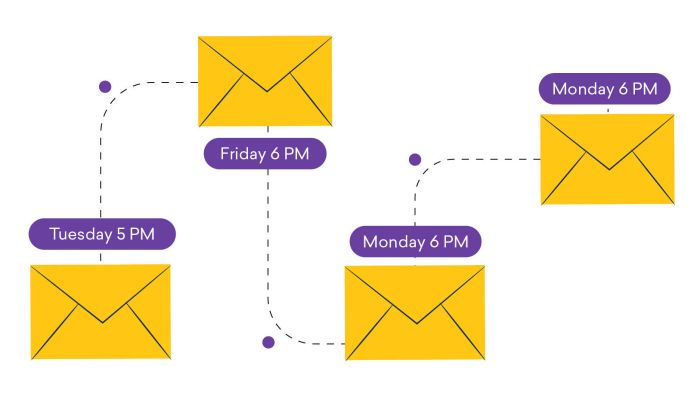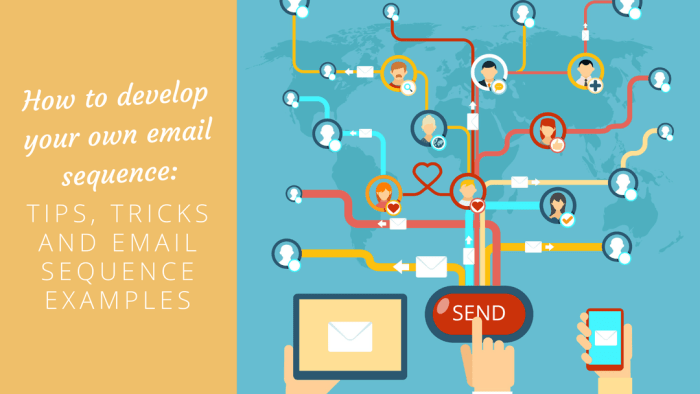Creating an Automated Email Sequence dives into the world of modern marketing strategies, offering businesses a way to connect with their audience on a whole new level. From setting goals to understanding your audience, this guide will walk you through the essential steps of crafting an effective email sequence.
Introduction to Automated Email Sequences: Creating An Automated Email Sequence
An automated email sequence is a series of pre-written emails that are automatically sent out to subscribers or customers based on specific triggers or schedules. These emails are designed to nurture leads, educate customers, promote products or services, and ultimately drive conversions.Automated email sequences offer a range of benefits for businesses, including saving time and resources by streamlining communication, improving customer engagement through personalized and timely messages, increasing conversions by guiding leads through the sales funnel, and enhancing customer retention by staying top of mind.
Examples of Industries Benefiting from Automated Email Sequences
- E-commerce: Automated email sequences can be used to send abandoned cart reminders, product recommendations, and order confirmations.
- Real Estate: Agents can utilize automated email sequences to follow up with leads, send property listings, and provide market updates.
- Education: Schools and online courses can benefit from automated email sequences to welcome new students, send course materials, and encourage engagement.
- Healthcare: Medical practices can use automated email sequences for appointment reminders, health tips, and patient education.
Setting Goals for Your Email Sequence

Setting clear goals before creating an automated email sequence is crucial for ensuring its effectiveness. By defining what you want to achieve, you can tailor your content and strategies to meet those objectives.Common goals that businesses aim to achieve through automated email sequences include:
Increasing Sales
- Encouraging repeat purchases through targeted promotions
- Upselling or cross-selling products based on previous purchases
- Reducing shopping cart abandonment rates through reminder emails
Building Customer Loyalty
- Providing valuable content and resources to engage customers
- Sending personalized recommendations to enhance the customer experience
- Collecting feedback and reviews to improve products and services
Driving Website Traffic
- Promoting new blog posts, products, or features through email campaigns
- Offering exclusive deals or discounts to incentivize clicks to the website
- Integrating social media links to encourage sharing and engagement
Aligning goals with the target audience is essential for the success of your email sequences. Understanding the needs, preferences, and behaviors of your subscribers allows you to create relevant and engaging content that resonates with them. By tailoring your messages to address specific pain points or interests, you can improve open rates, click-through rates, and overall engagement with your emails.
Understanding Your Audience
To create an effective automated email sequence, it is crucial to understand the needs and preferences of your audience. By tailoring your content to resonate with your subscribers, you can increase engagement and conversion rates significantly.
Segmenting Your Email List
Segmenting your email list based on different criteria allows you to send targeted messages to specific groups within your audience. Some methods for segmenting your email list include:
- Demographics such as age, gender, location, and income level
- Behavioral data like past purchases, website interactions, and email engagement
- Preferences such as content interests, communication frequency, and preferred communication channel
Personalization for Enhanced Engagement
Personalization plays a vital role in enhancing engagement and conversion rates in automated email sequences. By addressing subscribers by their name, recommending products based on their past purchases, and sending personalized content tailored to their preferences, you can create a more personalized experience that resonates with your audience.
Designing the Email Sequence

When it comes to designing an automated email sequence, it’s important to follow a typical structure that keeps your audience engaged and interested. A well-crafted email sequence can help nurture leads, build relationships, and drive conversions.
Creating Compelling Subject Lines and Email Content
To grab your audience’s attention, start with a catchy subject line that entices them to open the email. Keep it short, sweet, and relevant to the content inside. When it comes to the email content, make sure it’s personalized, valuable, and engaging. Use a friendly tone, address the recipient by name, and provide useful information or offers that resonate with them.
- Personalize the content to make the reader feel special and valued.
- Include visuals like images or graphics to break up the text and make the email more visually appealing.
- Keep the content concise and to the point, focusing on one main message or call-to-action per email.
- Use storytelling to connect with your audience on a deeper level and keep them interested in your brand.
The Importance of a Clear Call-to-Action, Creating an Automated Email Sequence
In each email of the sequence, it’s crucial to include a clear call-to-action (CTA) that tells the recipient what you want them to do next. Whether it’s signing up for a webinar, downloading a free resource, or making a purchase, the CTA should be prominent, persuasive, and easy to follow.
Remember, the goal of the email sequence is to guide your audience towards taking the desired action, so make sure your CTAs are compelling and well-positioned.
Automation Tools and Platforms
When it comes to automating your email sequences, there are several tools and platforms available in the market to help you streamline your campaigns and reach your audience effectively. Choosing the right automation tool is crucial for the success of your email marketing efforts.
Comparing Email Marketing Automation Tools
- Mailchimp: A popular choice for beginners, offering user-friendly templates and automation features.
- HubSpot: Ideal for businesses looking for a comprehensive marketing automation platform with CRM integration.
- ActiveCampaign: Known for its advanced automation capabilities and robust email marketing features.
- GetResponse: Great for e-commerce businesses with its powerful automation tools and segmentation options.
Key Features to Consider
- Automation Workflow Builder: Look for a platform that allows you to easily create and customize automated workflows for different segments of your audience.
- Segmentation Options: Ensure the tool offers robust segmentation capabilities to target specific groups of subscribers with personalized content.
- Integration with CRM: Choose a platform that seamlessly integrates with your existing CRM system to streamline data management and enhance lead nurturing.
- Reporting and Analytics: Opt for a tool that provides detailed metrics and insights to track the performance of your email sequences and optimize future campaigns.
Best Practices for Integration
- Map Out Your Workflow: Before integrating automation tools with your CRM or email marketing software, Artikel your workflow to ensure a seamless transition.
- Ensure Data Consistency: Make sure that the data shared between your automation platform and CRM is accurate and up-to-date to avoid errors in targeting and personalization.
- Test and Iterate: Continuously test and optimize your automated email sequences to improve engagement and conversion rates over time.